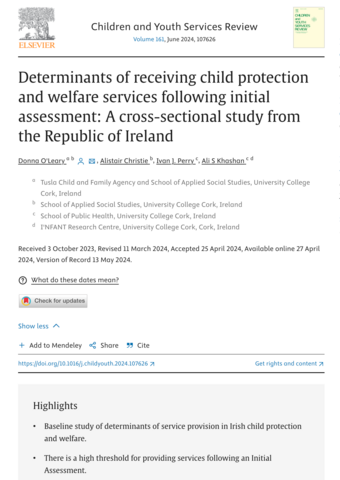Background:
Children receive child protection and welfare services when an initial assessment concludes that their needs and care would be significantly compromised without intervention or support. Evidence is lacking on this decision to provide services in the Irish child protection and welfare system.
Objective:
To identify determinants of receiving services following an Initial Assessment.
Participants and Setting:
All children (n = 508) whose Initial Assessments were completed during the first quarter of 2016 in one of the four regions (spanning seven social work departments) of Tusla, the national Child and Family Agency.
Methods:
A cross-sectional study used data manually coded from social workers’ case records. Poisson regression analysis calculated incident rate ratios for receiving ongoing service, adjusting for demographic factors, family level and wider determinants of child welfare to investigate associations between predictor variables and the decision to provide services.
Results:
38.5 % of children (n = 185) received ongoing child protection and welfare services. Risk factors for service provision included mother-perpetrated domestic violence (Incident Rate Ratio (IRR) 1.70 (95 % Confidence Interval (CI) 1.33, 2.19)), concerns about guidance and boundaries (IRR 1.66 (95 % CI 1.29, 1.14)), lack of emotional warmth (IRR 1.62 (95 % CI 1.30, 2.02)), prior abuse (IRR 1.59 (95 % CI 1.30, 1.95)), prior involvement (IRR 1.51 (95 % CI 1.15, 1.98)), intergenerational involvement (IRR 1.40 (95 % CI 1.10, 1.76)), health concerns (IRR 1.30 (95 % CI 1.07, 1.57)), and being aged 0–4 years (IRR 1.28 (95 % CI 1.03, 1.59)). Being reported by mandated professionals (IRR 0.71 (95 % CI 0.56, 0.90)), assessed by female social workers (IRR 0.72 (95 % CI 0.59, 0.89)), and, when separately examined, parental cooperation (IRR 0.64 (95 % CI 0.53, 0.77)) reduced the likelihood of receiving service. No differences were noted between departments.
Conclusions:
Service provision is largely driven by parental factors, prior involvement, and intergenerational abuse but gender disparities exist. Findings can be used to enhance decision strategies to improve outcomes for children and families.

